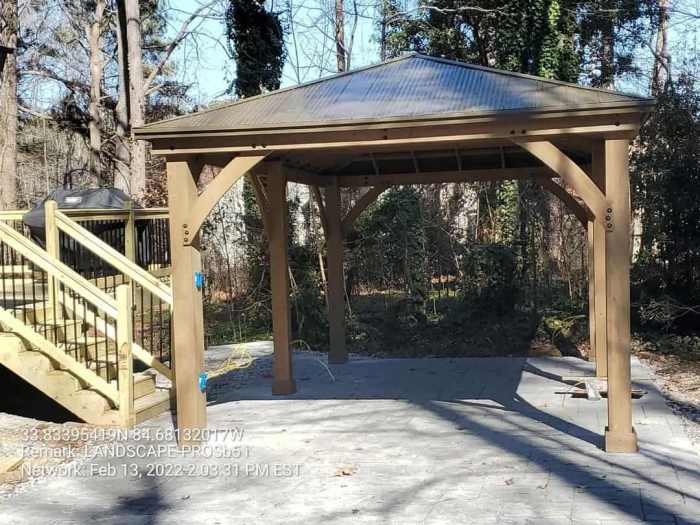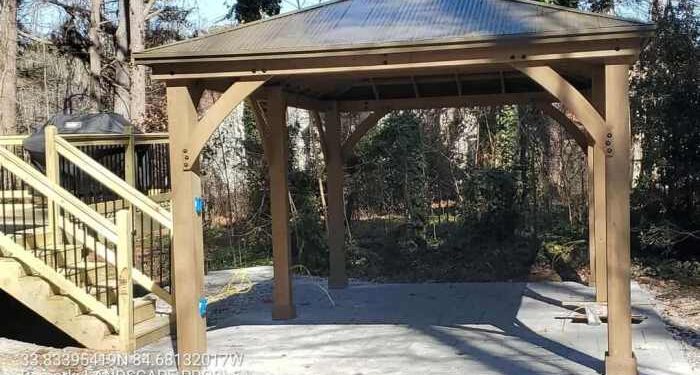Embark on a journey through the world of pergola installation services, where we unravel the intricacies of this craft and explore the benefits of professional expertise. From planning and preparation to maintenance and care, discover all you need to know about enhancing your outdoor space with a stunning pergola.
Introduction to Pergola Installation Services
When it comes to enhancing the outdoor space of your property, pergolas are a popular choice. Pergola installation services involve the professional construction and setup of these beautiful outdoor structures that provide shade, style, and functionality to your backyard or garden.
There are several benefits to hiring professionals for pergola installation. Firstly, experts have the knowledge and experience to ensure that the pergola is installed correctly, following all safety standards and building codes. This not only guarantees the structural integrity of the pergola but also ensures the safety of those who will be using the space underneath it.
The Importance of Proper Installation
Proper installation is crucial for the longevity of a pergola. When a pergola is not installed correctly, it can lead to issues such as instability, uneven weight distribution, and premature wear and tear. By hiring professionals for the installation, you can be confident that your pergola is built to last, with attention to detail and quality craftsmanship.
Types of Pergolas
When it comes to choosing a pergola for your outdoor space, there are several types available, each with its own unique features and benefits.
Materials Used in Pergola Construction
- Wood: Wood pergolas offer a natural and rustic look, perfect for traditional or rustic outdoor settings. They can be stained or painted to match your existing decor.
- Vinyl: Vinyl pergolas are low-maintenance and durable, making them a popular choice for homeowners looking for a hassle-free option. They are available in various colors and styles.
- Aluminum: Aluminum pergolas are lightweight, corrosion-resistant, and long-lasting. They require minimal maintenance and are ideal for modern and contemporary outdoor spaces.
Design Options and Customization Features
- Roof Style: Pergolas can have open roofs with slats for partial shade, solid roofs for full shade, or retractable canopies for adjustable shade levels.
- Column Design: Choose between round, square, or tapered columns to match the overall aesthetic of your outdoor space.
- Accessories: Enhance your pergola with accessories such as lighting, curtains, fans, and heaters for added comfort and functionality.
Planning and Preparation
When it comes to planning a pergola installation project, there are several key steps to consider to ensure a successful outcome. From selecting the right location to obtaining necessary permits, proper planning and preparation are essential.
Selecting the Right Location
- Consider the purpose of the pergola - whether it's for shade, privacy, or aesthetics.
- Take into account the direction of sunlight and prevailing winds to optimize comfort.
- Ensure the location is easily accessible and complements the overall design of your outdoor space.
Permits and Regulations
- Check with your local municipality to determine if a building permit is required for the installation of a pergola.
- Ensure compliance with zoning regulations, setback requirements, and any homeowner association guidelines.
- Consult with a professional to ensure all necessary permits and approvals are obtained before starting the installation.
Installation Process

Installing a pergola involves several steps that need to be followed carefully to ensure a successful outcome. It is essential to have the right tools and equipment on hand to make the process smoother. Additionally, being aware of common challenges and how to overcome them can help avoid potential setbacks during installation.
Step-by-Step Installation Process
- 1. Site Preparation: Begin by selecting the location for the pergola and ensuring the ground is level and free of any obstacles.
- 2. Assembly of Posts: Install the posts according to the design specifications, making sure they are securely anchored to the ground.
- 3. Attaching Beams and Rafters: Connect the beams and rafters to the posts, following the layout plan provided with the pergola kit.
- 4. Adding Cross Beams: Install the cross beams to provide additional support and enhance the overall structure of the pergola.
- 5. Finishing Touches: Once the main structure is in place, add any additional decorative elements or accessories to personalize the pergola.
Tools and Equipment Needed
- - Power drill and screws for securing components
- - Ladder for reaching higher areas
- - Level and measuring tape for accurate placement
- - Hammer and nails for additional reinforcement
- - Saw for cutting and adjusting materials as needed
Common Challenges and Solutions
- - Uneven Ground: Use shims or adjust the post lengths to accommodate uneven terrain.
- - Incorrect Assembly: Refer to the instruction manual carefully and double-check each step to avoid mistakes.
- - Weather Conditions: Work on installing the pergola during favorable weather to prevent delays or damage to materials.
- - Lack of Assistance: Enlist the help of a friend or family member to make the installation process easier and safer.
Maintenance and Care
Proper maintenance is essential to ensure your pergola remains in good condition for years to come. Regular care and upkeep will not only extend the lifespan of your pergola but also help it retain its aesthetic appeal.
Cleaning and Preserving Different Types of Pergolas
- Wooden Pergolas: Use a mild detergent mixed with water to clean the wood surface. Avoid harsh chemicals that can damage the wood. Apply a fresh coat of sealant or stain every few years to protect the wood from the elements.
- Metal Pergolas: Wash metal pergolas with a mixture of water and mild soap. Remove any rust spots promptly to prevent further corrosion. Apply a rust-resistant paint to protect the metal.
- Vinyl Pergolas: Clean vinyl pergolas with a solution of water and vinegar. Avoid using abrasive cleaners that can scratch the surface. Apply a vinyl protectant to maintain the color and shine of the material.
Seasonal Maintenance Routines for Pergolas
- Spring: Inspect the pergola for any signs of damage or wear. Replace any broken or loose parts. Clean the structure thoroughly to remove dirt and debris accumulated during the winter months.
- Summer: Check for insect infestations or mold growth. Trim any plants or vines growing on the pergola to prevent damage. Apply a fresh coat of protective sealant if needed.
- Fall: Remove leaves and debris from the pergola to prevent moisture buildup. Secure any loose fittings or hardware. Prepare the pergola for winter by covering it with a weatherproof tarp.
- Winter: Protect the pergola from heavy snow loads by regularly clearing off snow accumulation. Check for any ice formation that could cause damage. Inspect the structure for any signs of wear and tear.
Concluding Remarks
As we conclude our exploration of pergola installation services, we leave you with a deeper understanding of the process and its significance. Whether you're a novice or a seasoned homeowner, the allure of a beautifully installed pergola awaits, promising years of enjoyment and aesthetic appeal.
FAQ Resource
What are the benefits of hiring professionals for pergola installation?
Professional installers bring expertise, efficiency, and quality to the project, ensuring a durable and well-crafted pergola.
How do I choose the right location for my pergola?
Consider factors like sunlight exposure, proximity to the house, and existing landscaping to select an ideal location for your pergola.
What are the common maintenance tasks for a pergola?
Regular cleaning, checking for structural integrity, and applying protective coatings are essential maintenance tasks for preserving a pergola.














